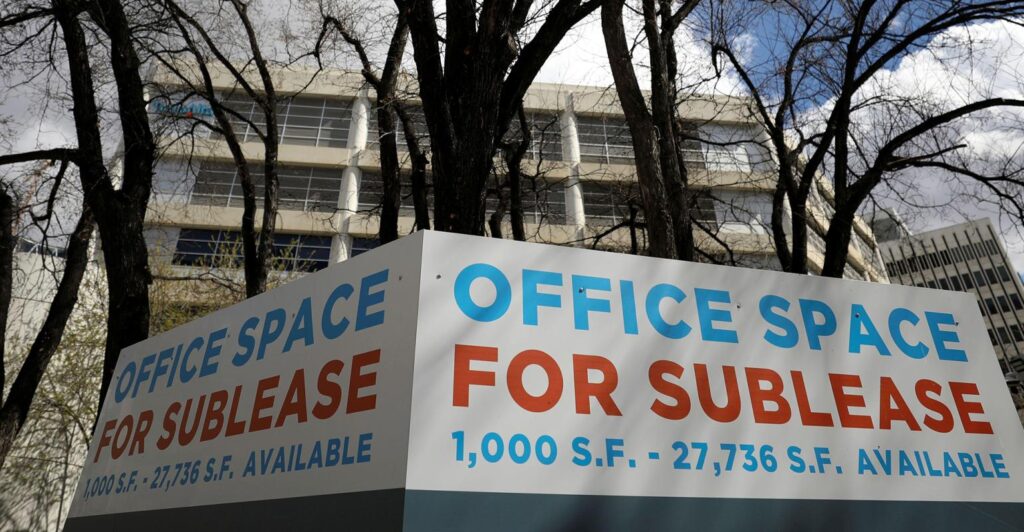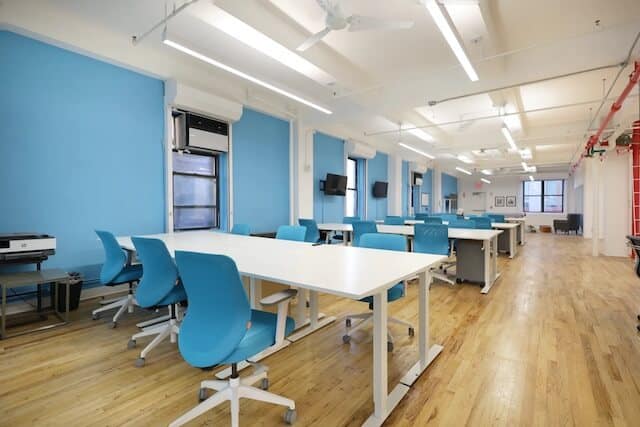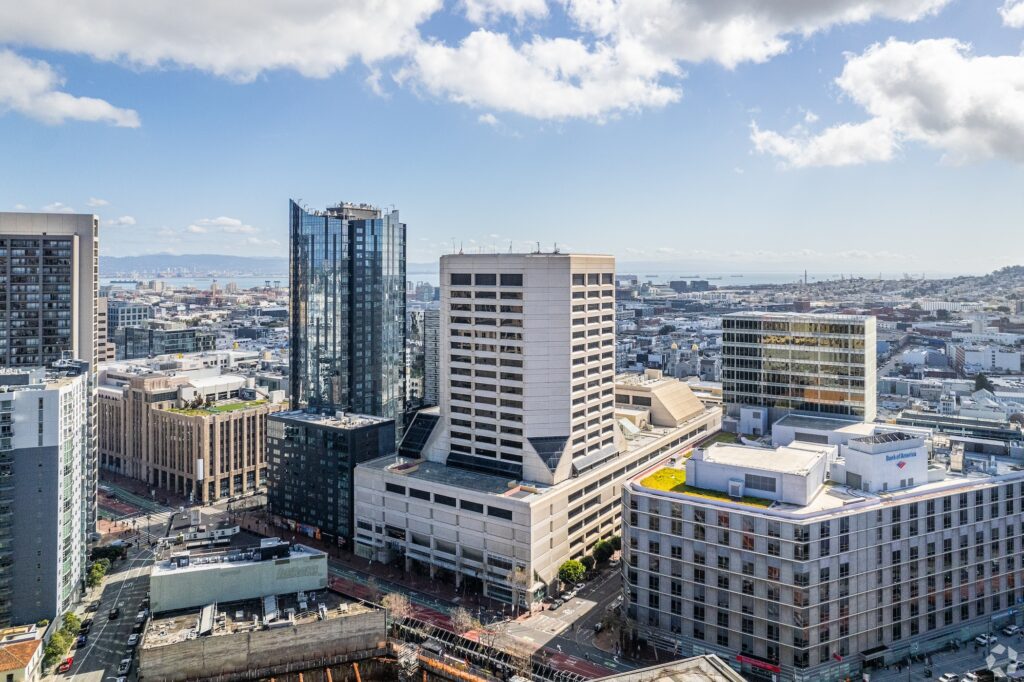As of early 2025, the commercial real estate market in the San Francisco Bay Area persists in exhibiting high sublease availability; however, indications of steady enhancement are emerging. The Sublease Market 2025 is shaping the landscape, with sublease space dropping by 3% in the fourth quarter of 2024, falling below 8 million square feet for the first time since 2022. Notwithstanding this decrease, the Sublease Market 2025 shows that sublease availability constitutes over 21% of the total available space, surpassing the pre-pandemic average of 14-15%.

The office vacancy rate in San Francisco is a crucial metric of market vitality. The city’s official data dashboard presents quarterly updates on these rates, providing insights into office space demand.
Despite a significant volume of sublease space available, the recent decline in availability indicates stability. Nevertheless, economic uncertainties endure, and enterprises are urged to actively observe market trends when evaluating sublease alternatives.
The increased availability of sublease space has considerable ramifications for landlords as discussed below. The Sublease Market 2025 landscape is changing rapidly, making it critical for stakeholders to stay informed.
Sublease Market 2025: Increased Competition and Pressure on Rental Rates
The increase in sublease availability presents additional opportunities for prospective tenants, thereby heightening competition among property owners, landlords and property managers managing leasing. Sublease opportunities frequently present reduced rates and pre-existing fit outs, rendering them appealing alternatives to direct leasing agreements. This dynamic necessitates that landlords contemplate the reduction of their asking rentals to maintain competitiveness in the market. For example, certain landlords have taken the initiative to reduce their asking rentals by as much as 10% to finalize lease agreements prior to the introduction of additional sublease space into the market.

Below are several ways landlords and property managers are combating the current market forces and conditions.are several ways landlords and property managers are combating the current market forces and conditions.
Owners Enhancing Property Amenities are Garnering More Interest from Prospective Sub-Lessees
Smart landlords and property managers are investing in modernizing spaces to stand out from competitors and justify premium rental rates by implementing the following:
- High-speed internet (and infrastructure capability for future improvements) and tech-friendly office layouts which are implemented by actual design professionals.
- Smart building technology for energy conservation and comfort (automated lighting, HVAC systems)
- Curb appeal including upgraded lobbies, common areas, and wellness spaces (e.g., gyms, day care facilities)
- LEED certification for sustainability and green compliance
Data shows these type improvements are working because tenants are increasingly attracted to properties offering advanced amenities and energy efficiency.

Owners and Property Managers Are Offering More Flexible Lease Terms
Provide tailored leasing options to accommodate tenant and sub-lessee needs.
- Shorter lease durations with renewal options
- Co-working or shared office space models.
- Rent concessions (temporary discounts or rent-free months)
Why It Works: Flexibility can attract smaller or cautious businesses seeking lower commitments in uncertain market conditions. This type of flexibility is leading to more sub-leasing in the SF and Silicon Valley markets.
Build Strong Tenant Relationships and Retention Programs
Focus on tenant satisfaction to reduce turnover and maintain occupancy.
- Regular and fluid communication and tenant engagement events
- On-demand maintenance and responsive property management 24/7 responsiveness
- Incentives for early renewals or tenant referrals e.g., rewards and bonuses
- Allow and encourage tenant feedback.
Why It Works: Happy tenants are more likely to renew leases, reducing vacancy rates and providing stability in a competitive market. No one likes to move their businesses unless they are given incentives to move.
Impact on Property Valuations and Financial Stability
Elevated vacancy rates and declining rental incomes can lead to reduced property valuations – its simple math. In San Francisco, the availability rate reached a record 36.3% in the third quarter of 2023, reflecting the challenges landlords and property managers faced in maintaining occupancy and revenue streams.
Diminished property values may result in landlords seeking reassessments to lower property taxes, potentially affecting municipal revenues. No property owner wants to be faced with this situation, but there are some ideas below to help combat this.
Owners and Property Managers can Reposition or Repurpose the Property
Adapt, remodel, or repurpose existing spaces to meet evolving market demands.
- Convert or remodel underutilized office spaces into residential units or mixed-use developments – requires governmental involvement.
- Offer flexible office spaces or co-working environments – can be done with relative ease.
- Target niche sectors, such as life sciences or creative industries requiring specialized layouts.
Why It Works: Diversifying the property or some space within a larger building can increase tenant demand and stabilize cash flow, positively impacting property valuations.
Optimize Operating Expenses without sacrificing services or offerings.
Identify and reduce unnecessary costs to improve the property’s financial performance.
- Conduct energy audits to reduce utility expenses – and/or consider installing energy efficient components (some government programs can help by participating in these costs)
- Implement strategic preventative maintenance programs to minimize repair costs.
- Outsource property management functions for operational efficiency – an outside professional property management team can sometimes be significantly cost effective depending on lease terms already in place.
Why It Works: Lower pinpointed operating expenses can improve net operating income (NOI), which directly affects property valuation – do the math.
Explore Creative Financing and Tax Strategies
Proactively and professionally manage debt obligations and optimize financial positioning.
- Negotiate with lenders for favorable loan restructuring or refinancing terms – or hire a financial professional to act on your behalf.
- Take advantage of tax incentives for property upgrades or energy-efficient improvements – many government programs are in place.
- Seek calculated partnerships or joint ventures to share investment risks and access additional capital.
Why It Works: Strengthening financial stability improves the property’s perceived – and actual value and reduces the likelihood of distressed sales.

Reduce the Financial Strain and Risk of Loan Defaults
In the current market environment, the combination of high vacancy rates and downward pressure on rents can make it difficult for landlords to fulfill their financial obligations. This can be a burden for landlords. At the same time as some property owners are attempting to bargain with their lenders to avoid foreclosure, other property owners are facing the possibility of defaulting on their payments, which could result in the sale of property that is in a distressed state. Although this is a circumstance that no one would ever choose to find themselves in, the following are some recommendations that should be taken into consideration.
Proactively Engage with Lenders for Increased Options
Open and constant communication with lenders or underwriters can help landlords and asset managers govern difficult financial obligations.
- Seek to negotiate loan modifications or workarounds, such as interest-only payments or extended loan terms or other methods available from the lender.
- Attempt to receive a temporary forbearance agreement to reduce immediate payment burdens.
- Refinance high-interest loans for lower rates if possible.
Why It Works: Initiative-taking and consistent negotiations demonstrate responsible financial management and may prevent foreclosure actions or further detrimental treatment.
Creatively Develop a Diversity of Income Streams
Generate additional revenue from the property or other sources by being creative and considering all sources of income from available resources.
- Lease unused space for non-traditional uses, like pop-up shops or storage facilities.
- Install rooftop solar panels and sell excess energy back to the grid.
- Install public EV charging stations (several government programs help finance these infrastructure projects – check your state and local energy departments)
- Offer parking or event space rentals during off-peak times.
Why It Works: Supplemental income can help offset loan payments/obligations and stabilize cash flow.
Implementing a Company-Wide Aggressive Tenant Retention and Leasing Strategies
Focus on maximizing occupancy and securing stable long-term leases.
- Offer rent discounts or concessions to attract and retain tenants.
- Provide fit-out contributions or flexible leasing terms to entice prospective tenants.
- Collaborate closely with commercial brokers to aggressively market available spaces.
There is a Necessity for Strategic Adaptation for Long-Term Leasing Success
It is imperative that landlords and property managers will be required to make strategic adjustments to properly meet the issues that are provided by the wide sublease market in most economic situations. This may include making investments in property renovations to attract tenants, offering lease agreements that are flexible, or remodeling office spaces to correspond with the shifting demands of the market. The implementation of such preventative measures is paramount for landlords, property managers, and asset managers who are looking to maintain occupancy levels and guarantee financial stability in the face of intense competition.
Below are three actual examples from across the United States which illustrate this idea.
Hudson Pacific Properties (San Francisco) – Creative Use of Vacant Office Space
Hudson Pacific facilities is a real estate investment and development firm that focuses on the development, purchase, and administration of office and studio facilities, notably in high-demand regions in the United States such as San Francisco.
There have been a number of noteworthy projects that Hudson Pacific has participated in in San Francisco. These projects have frequently been undertaken in collaboration with other developers or stakeholders to improve the urban landscape and contribute to the expanding economy of the city. Their work consists of:

The formation of strategic partnerships involves working together with other real estate developers, local businesses, and government bodies to build developments that are in line with the requirements of the community.
The concept of sustainable development refers to the practice of concentrating on environmentally friendly building procedures and sustainable design to attract tenants who are looking for contemporary and “green” office spaces.
In the realm of innovation and technology, the process of developing spaces that are tailored to the needs of tech tenants is particularly important in industries such as media and technology, where adaptability and contemporary conveniences are fundamental.
Community engagement refers to the process of involving local stakeholders in the planning process to guarantee that developments of any kind will be advantageous to the local inhabitants and businesses.
The HUB, which is one of their main developments in the San Francisco area, is a place that features contemporary office spaces and is intended to attract organizations who are at the forefront of innovation.
Empire State Realty Trust (New York City) – Sustainability and Building Upgrades
Empire State Realty Trust (ESRT) is a real estate investment trust (REIT) that is headquartered in New York City. It is principally recognized for its ownership, management, and leasing of a portfolio of office and retail properties, which includes the world-famous Empire State Building.
When it comes to collaborations for development, ESRT often participates in the following:
Urban development projects involve forming partnerships with other developers and representatives of the local government to establish mixed-use developments. These developments typically consist of office space, residential units, and retail components.

Sustainability Initiatives: With a primary emphasis on environmentally responsible building practices, ESRT has made substantial investments in energy efficiency and sustainability across all their sites, thereby establishing a benchmark in the real estate and construction sector.
The process of collaborating closely with community stakeholders to ensure that developments fulfill the requirements of the local community and make a good contribution to the urban landscape is referred to as community engagement.
The process of investing in old properties and undergoing considerable repairs to increase their worth and appeal to contemporary renters is referred to as major renovations and rehabilitation work.
One noteworthy example of their development activities is the Empire State Building itself, which has undergone extensive renovations to improve energy efficiency and tenant amenities while keeping its historical relevance. These modifications have been conducted during the course of their development initiatives.
Jamestown Properties (Atlanta) – Conversion of Commercial Space to Mixed Use
Located in Atlanta, Jamestown Properties is a real estate investment and management company that is well-known for its forward-thinking approach to the creation and investment of real estate investment opportunities. The transformation of commercial premises into mixed-use buildings, which often include residential, office, retail, and sometimes hospitality components within a single project, is one of their primary areas of concentration.
Jamestown Properties has participated in a number of different programs in Atlanta, including the following:
Adaptive reuse is the process of transforming commercial buildings that are underutilized or vacant into lively mixed-use locations. This allows for new life and purpose to be created while retaining historical components during the process.
The term “community-centric design” refers to the practice of concentrating on designs that encourage community involvement and accessibility. These designs frequently include public areas, parks, and settings that are hospitable to pedestrians.
Through the incorporation of sustainable techniques into rehabilitation projects, such as energy-efficient systems, green roofs, and environmentally friendly materials, sustainability and innovation are being brought together.
The process of collaborating with local stakeholders, businesses, and government bodies to ensure that the development satisfies the requirements of the community and encourages economic expansion is referred to as neighborhood partnership and economic development.
Among the most noteworthy examples of such a project is the transformation of large commercial assets into locations such as Ponce City Market, which has become a bustling center of activity with stores, restaurants, and office spaces, all while preserving the historic character of the building.

Conclusion
In a nutshell, the current dynamics of the sublease market in the San Francisco Bay Area and Silicon Valley present landlords, property and asset managers with a substantial number of challenges, one of which is the obligation to implement strategic steps in order to mitigate the financial repercussions and keep their leadership position in the market. The ideas presented above are the tip of the iceberg but should provide some guidance for those professionals looking to be creative and flexible.
David currently is the broker/owner of several real estate related businesses which manage and maintain 300+ client properties on the San Francisco Peninsula.
Trust, transparency, and performance guarantees are the foundation of these businesses. David challenges anyone to find a PM professional that offers services similar - extensive education, customer service, and performance guarantees.
David also provides consulting for his clients on property development feasibility, construction, and complex real estate transactions.
David has authored a published law review article, three real estate books, and over 150+ real estate blog articles.
- “Wildfires, Insurance & Mortgages: Will Your Home Survive the Financial Aftermath?” - March 3, 2025
- What’s Driving California’s Commercial Real Estate Shakeup? - February 27, 2025
- Critical Issues in Triple Net Leases Investors Should Know - February 14, 2025

